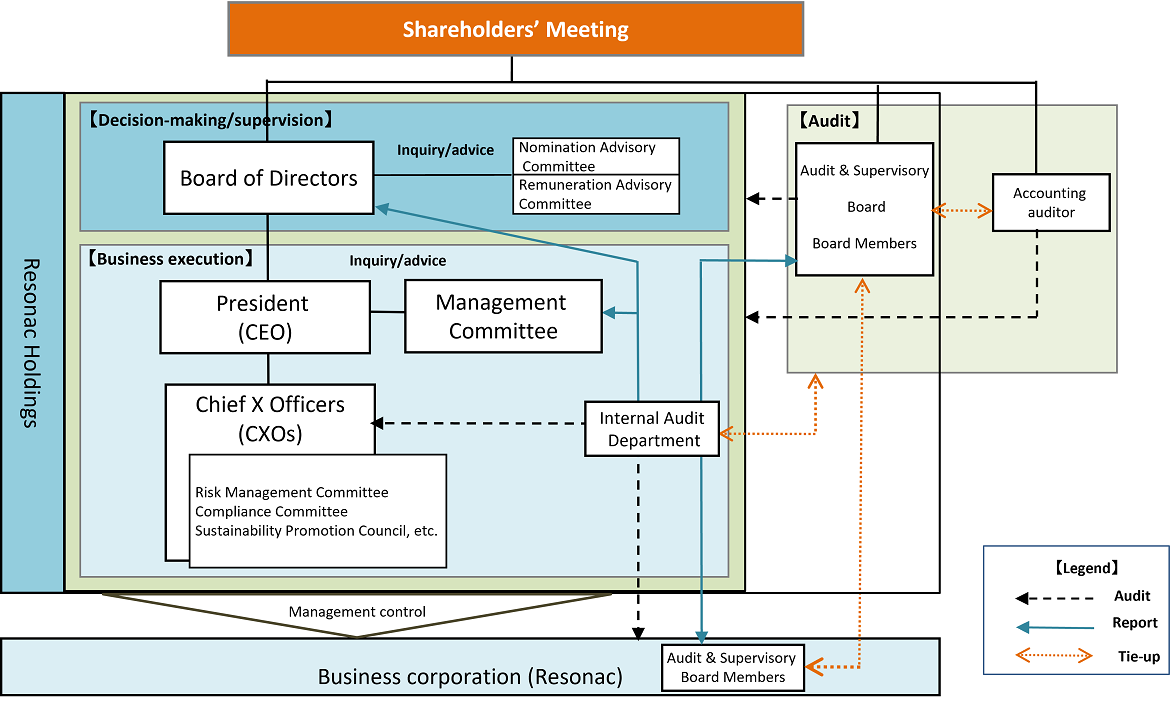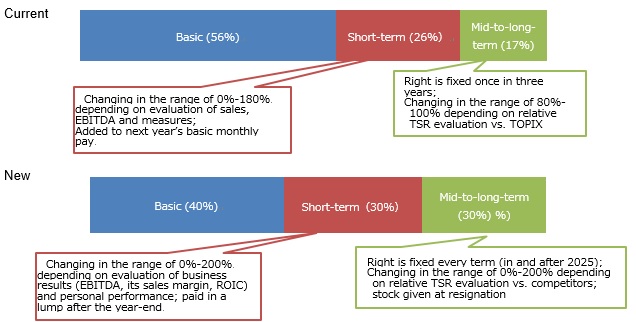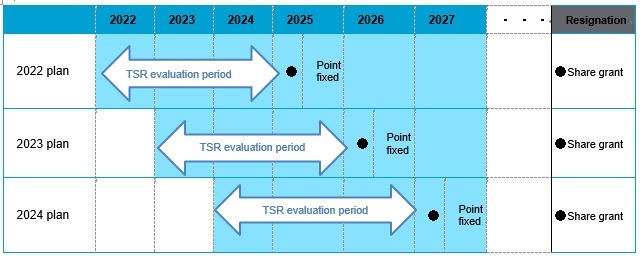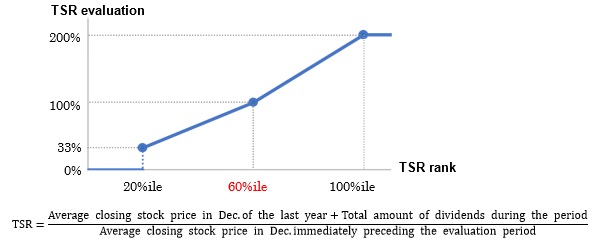Corporate Governance
- Corporate Governance Basic Policies (Amended March 1, 2024)

- Corporate Governance Report(March 28, 2024)

Basic Views on Corporate Governance
Resonac (the “Company”) shall hereby establish the Corporate Governance Basic Policies in order to increase corporate value and shareholders’ common interests through appropriate cooperation with all stakeholders including shareholders.
The Company formulated the Corporate Governance Basic Policies in line with Japan’s Corporate Governance Code and discloses the policies at its website.
Corporate Governance System
The Company, as a pure holding company, specializes in Group strategy and listed company functions. While flexibly responding to business challenges, the Company appropriately allocates its management resources in consideration of the entire Group, for business tie-up, M&A, etc.
The Company introduced a corporate officer system to explicitly divide management oversight and business execution functions, giving authority to Chief X Officers (CXOs) and chiefs of Business Units to execute business. In order to strengthen functional independence, objectivity, and accountability of the Board of Directors, the Company has organized the Nomination Advisory Committee and the Remuneration Advisory Committee as advisory bodies for the Board of Directors. Independent Outside Directors represent the majority of both committees.

Corporate Governance System
Board of Directors
To increase agility of business execution, the Board of Directors delegates part of decisions on important business execution to President and other corporate officers. The Board of Directors mainly focuses on deliberations and decisions concerning basic policies for management, establishment of the internal control system, etc. as well as oversight of execution of duties by Directors and Corporate Officers. We have also established an agile management system to quickly respond to changes in the business environment, and limit the term of office of directors to one year to more clearly define management responsibilities of Directors.
Audit & Supervisory Board
The Company has adopted the Audit & Supervisory Board system. The Audit & Supervisory Board Members attend the Board of Directors’ meetings and other important internal meetings, offering opinions as necessary. They also conduct audits on business execution through on-site investigations, interviews with responsible persons, inspection of important documents, and other appropriate measures, so as to provide suggestions, advice, and recommendations for securing soundness in management. In addition, Standing Statutory Members of the Audit & Supervisory Board concurrently serve as Audit & Supervisory Board Members of the business corporation to enhance audits on Group companies.
Nomination Advisory Committee
The Company has established the Nomination Advisory Committee, advisory bodies to the Board of Directors. Independent Outside Directors represent the majority of its members for the Nomination Advisory Committee. The Committee reports to the Board of Directors after deliberating matters related to election of candidates for Directors and Audit & Supervisory Board Members.
Remuneration Advisory Committee
The Company has established the Remuneration Advisory Committee, advisory bodies to the Board of Directors. Independent Outside Directors represent the majority of its members for the Remuneration Advisory Committee. The Committee reports to the Board of Directors after deliberating matters related to appointment of senior management, and remuneration of Directors and Corporate Officers, respectively.
Management Committee
The Company and its business corporation Resonac have formed the Integrated Management Committee that gives advice to President on important matters and serves as a body preceding the Board of Directors. For investment matters escalated to the Management Committee, their risks are analyzed and their results and progress are managed through preliminary risk review and assessment by task teams.
Committees and Promotion Councils
Under CXOs in charge of respective functional areas, the Company has established the Risk Management Committee, Compliance Committee, Sustainability Promotion Council, and other committees.
Risk Management Committee
The Committee deliberates on the Group's overall risk management system, the content of risk information to be disclosed externally, and the evaluation of the Group's most important risks and measures to address them. Risk Management
Compliance Committee
The Committee discusses the Company-wide compliance promotion policy, mid-term activity plan, etc., and reports on the progress of the annual plan and the status of issues to be addressed.Compliance
Sustainability Promotion Council
The Promotion Council discusses mid- to long-term strategies, non-financial KPIs, stakeholder engagement, and other issues. For important issues that cross organizational boundaries, projects, etc., are established under the Promotion Council.Sustainability
Internal Audit Department
The Company has organized the Internal Audit Department reporting directly to the President. The Internal Audit Department forms annual internal audit plan under the provisions of the Company’s Internal Audit Rules, audits situations of compliance, conduct of business and internal control system of the Group including affiliated companies, reveals potential risks concerning overall business activities, and reports results of internal audit to the top management, the Board of Directors and the Audit & Supervisory Board.
In addition, the Internal Audit Department cooperates with the Accounts Auditor and Audit & Supervisory Board Members through various measures including periodic briefing session about annual internal audit pan and results of internal audit, while paying attention to each auditing body’s independence.
Accounting audits
The Company concluded an auditing contract with KPMG AZSA, and this audit corporation performs accounting audits for the Company. The Accounting Auditor confirms the annual audit plan with the Audit & Supervisory Board Members and reports the audit results to them. The Accounting Auditor and the Audit & Supervisory Board Members also exchange information and views as required, to promote their cooperation.
Corporate Governance Initiatives
Attendance at Meetings of the Board of Directors and Auditit & Supervisory Board(2023)
- * Marked Directors and Audit & Supervisory Board Member :
Number of attendances after appointment at the Ordinary General Meeting of Shareholders held in March 2023
Board Directors
Audit & Supervisory Board Members
Attendance at Nomination Advisory Committee and Remuneration Advisory Committee(April 2023~March 2024)
Nomination Advisory Committee
Remuneration Advisory Committee
Approach to the balance and size of the Board of Directors and Audit & Supervisory Board
1. Board of Directors
The Board of Directors shall have a personnel structure giving thoughtful attention to a good balance among specialties, experience, and other factors, regardless of gender, nationality or age, and the size of the Board of Directors shall be set so as to ensure prompt decision-making and appropriate oversight of business execution. In addition, one-third or more of the Board of Directors shall consist of Independent Outside Directors with extensive experience and broad insight in order to secure the appropriateness of business execution and to increase the effectiveness of oversight.
The Board of Directors shall identify the skills necessary to improve its effectiveness, and disclose the status of fulfillment of such skills.
2. Audit & Supervisory Board
The Audit & Supervisory Board shall have a personnel structure that includes Member(s) who has sufficient expertise in financing or accounting. In order to ensure a structure that will increase the effectiveness of audits through independence and advanced information gathering capabilities, Standing Statutory Members of Audit & Supervisory Board shall be appointed and a half or more of the Audit & Supervisory Board shall be Outside Members of Audit & Supervisory Board.
Criteria on the independence of outside directors
The Board of Directors has established independence standards for Outside Directors based on independence criteria stipulated by law and the Tokyo Stock Exchange and selects candidates who meet the standards. See the Attachment of Corporate Governance Basic Policies for the independence standards.
Policies and procedures for determining the remuneration of directors, Audit & Supervisory Board members, and corporate officers
Outline of Director Compensation Scheme
The outline of the Company’s director compensation scheme in and after 2022 is as follows:
1.Basic policy
- A compensation scheme appropriate for recruiting and maintaining excellent human resources inside and outside Japan as the Company aims to become a world-leading chemical company for advanced functional materials
- A compensation scheme that will help motivate efforts to achieve financial goals and increase medium-to-long-term enterprise value, thereby contributing to sustainable growth of the Group
- A transparent, fair and rational process for deciding compensation from the viewpoint of accountability to all stakeholders, including shareholders
- A compensation scheme appropriate for the role and responsibility for supervising the management of the Company from an independent and objective standpoint
2.Composition and levels of compensation
The compensation for executive directors and corporate officers consists of basic compensation (fixed compensation) based on position, short-term performance-linked compensation, and medium-to-long-term performance-linked compensation (stock-based compensation). In case of a standard amount for President and CEO, the proportions of basic, short-term performance-linked, and medium-to-long-term performance-linked compensations are roughly 40%:30%:30%. Compensations for other executive directors and corporate officers are decided in line with the case of president. As for director and chairman of the board (without right of representation), short-term performance-linked compensation will not be given in view of its basic role of supervising the management. Compensation paid to outside directors and members of the Audit & Supervisory Board will be only basic compensation in consideration of their roles and responsibilities. In deciding the composition and levels of compensation, we will use objective market research data provided by external specialized institutions (such as Willis Towers Watson’s database regarding compensation for executives). We will consider the results of comparison with global chemical or other material companies of a similar scale.
Graph 1 Type of compensation and scope of payment

Graph 2 Percentage of compensation components for President and CEO (image)
3.Incentive compensation
Incentive compensation will be granted according to performance based on indexes of long-term numerical goals included in the integrated company’s long-term vision. It is intended to urge performance of tasks for realizing vision and strategy under the compensation scheme linked to business results and enterprise value.
Payment to each person is decided by multiplying standard value (decided in advance based on position) by performance evaluation coefficient (changing in the range of 0%-200%). The coefficient consists of overall business results evaluation (70%) and personal evaluation (30%). In the case of representative director and chairman of the board, only overall business results evaluation is considered.
Indexes of overall business results evaluation consist of the amount of consolidated EBITDA (20%), the ratio of consolidated EBITDA to sales (30%), and ROIC (20%). As for the first two, evaluation is made relative to the degree of achievement of goals for each term. As for ROIC, evaluation is made on the basis of the average for the past three years.
Personal performance evaluation is made by the Compensation Advisory Committee entrusted by the Board of Directors concerning individual goals, evaluation, and the amount of payment. In case of misconduct, the Company may nullify the right to receive benefit or demand return of compensation, depending on the timing of misconduct and the timing of its revelation. The Board of Directors will make a decision on the matter after deliberations at the Compensation Advisory Committee.
Graph 3 Evaluation indexes of short-term performance-linked compensation (bonuses)
Under the new scheme, points are given by multiplying standard figures (decided in advance based on position) by TSR evaluation coefficient (changing in the range of 0%-200%). TSR evaluation coefficient will be decided based on the Company’s rank order of three-year relative TSR evaluation (percentile, hereinafter “%ile”) by comparison with competitors in the chemical/textile industries having similar business models and of the same size or larger. To encourage realization of the long-term vision, TSR coefficient will be set at 100% when the Company’s rank order is in 60%ile, while it will be 0% when the Company’s rank order is below 20%ile. To promote long-term sharing of value with shareholders, shares will be given in a lump after resignation according to cumulative points. In case of misconduct, the Company may nullify the right to receive benefit or demand return of compensation, depending on the timing of misconduct and the timing of its revelation. The Board of Directors will make a decision on the matter after deliberations at the Compensation Advisory Committee.

Graph 4 TSR evaluation period and share grant (image)

Graph 5 TSR evaluation coefficient
4. Compensation governance
The Company’s Compensation Advisory Committee is chaired by an independent outside director, and independent outside directors/auditors account for the majority of committee members. The committee will make proposals and reports as necessary to the Board of Directors in view of the latest situation concerning executive compensation and market trends, results of comparison with relevant competitors, and other pieces of advice. To ensure high levels of independence and objectivity, decisions on compensation for respective directors will be entrusted to the Compensation Advisory Committee as from 2022. the Company has appointed Willis Towers Watson, an external consultancy, as advisor.
Amount of remuneration paid to Directors and Audit & Supervisory Board Members (2023)
- 1. The amounts of "Base Compensation" and "Short-Term Performance-Linked Compensation" above are the total amount of compensation paid in fiscal 2023 (all monetary compensation).
- 2. The amount of "STI" above is the total amount of remuneration paid in March 2023 (all monetary remuneration) based on the results of business performance, etc. in FY 2022.
- 3. The above "LTI" amount is the total amount expensed in FY2023. The Company's LTI is the number of shares of the Company's stock determined based on the results of the three-year TSR (Total Shareholder Return) evaluation, which is deferred and delivered at the time of retirement The LTI is managed through a stock benefit trust (BBT) of Mizuho Trust & Banking Co.
- 4. The amount of remuneration for directors for FY 2022 and beyond was resolved at the 113th Annual General Meeting of Shareholders held on March 30, 2022 as follows: for STI and LTI, the amount is for directors excluding outside directors.
- 5. At the 96th Ordinary General Meeting of Shareholders held on March 30, 2005, it was resolved that the amount of remuneration for Audit & Supervisory Board Members shall be no more than 12 million yen per month. As of the close of the said General Meeting of Shareholders, the number of Audit & Supervisory Board Members was four, including three outside auditors.
Evaluation of the Board of Directors’ Effectiveness
Evaluation method
The Company evaluates the effectiveness of the Board of Directors every year, aiming to strengthen corporate governance and improve effectiveness of the Board of Directors in and after the next fiscal year. To be specific, in December 2023, the Company surveyed respective Directors and Audit & Supervisory Board Members through unidentified questionnaires and free descriptions to evaluate the effectiveness of the Board of Directors in fiscal 2023. Then, in March 2024, the Board of Directors held a meeting for all directors and Audit & Supervisory Board members to discuss the collected self-evaluation results and the monitoring function of the Board of Directors deliberated upon during the trainings among directors and corporate officers held in December 2023, create a summary of the evaluation results for fiscal 2023, and formulate an action plan for fiscal 2024. Note that we have outsourced the questionnaire survey and aggregation of the results to an outside institution in order to ensure its objectivity and enhance future effectiveness of the Board of Directors.
Evaluation results (Actions taken in 2023)
[Strategic/companywide issues]
- Business strategies, portfolio reform, and human resource strategies Strategies for R&D and intellectual properties, governance system
- Material issues for sustainability
- Progress in risk management promotion and other important CXO issues, etc.

Changes in the characteristics of matters discussed at the Board of Directors’ meetings caused by changes in standards for bringing up matters for discussion to the Board of Directors’ meetings
Action plan for fiscal 2024
Action plan for fiscal 2024 based on the reviews of business execution in fiscal 2023 is as follows.
